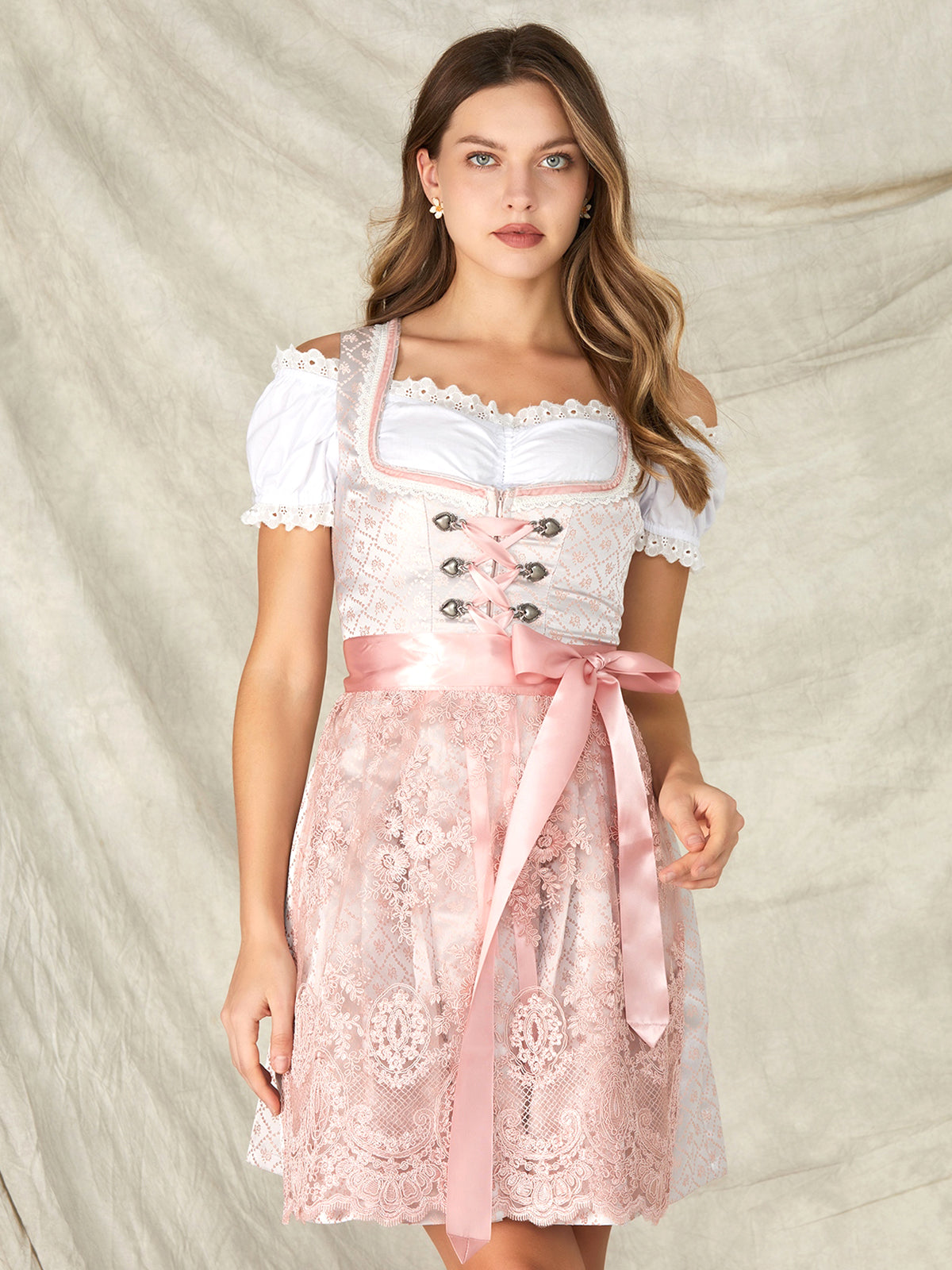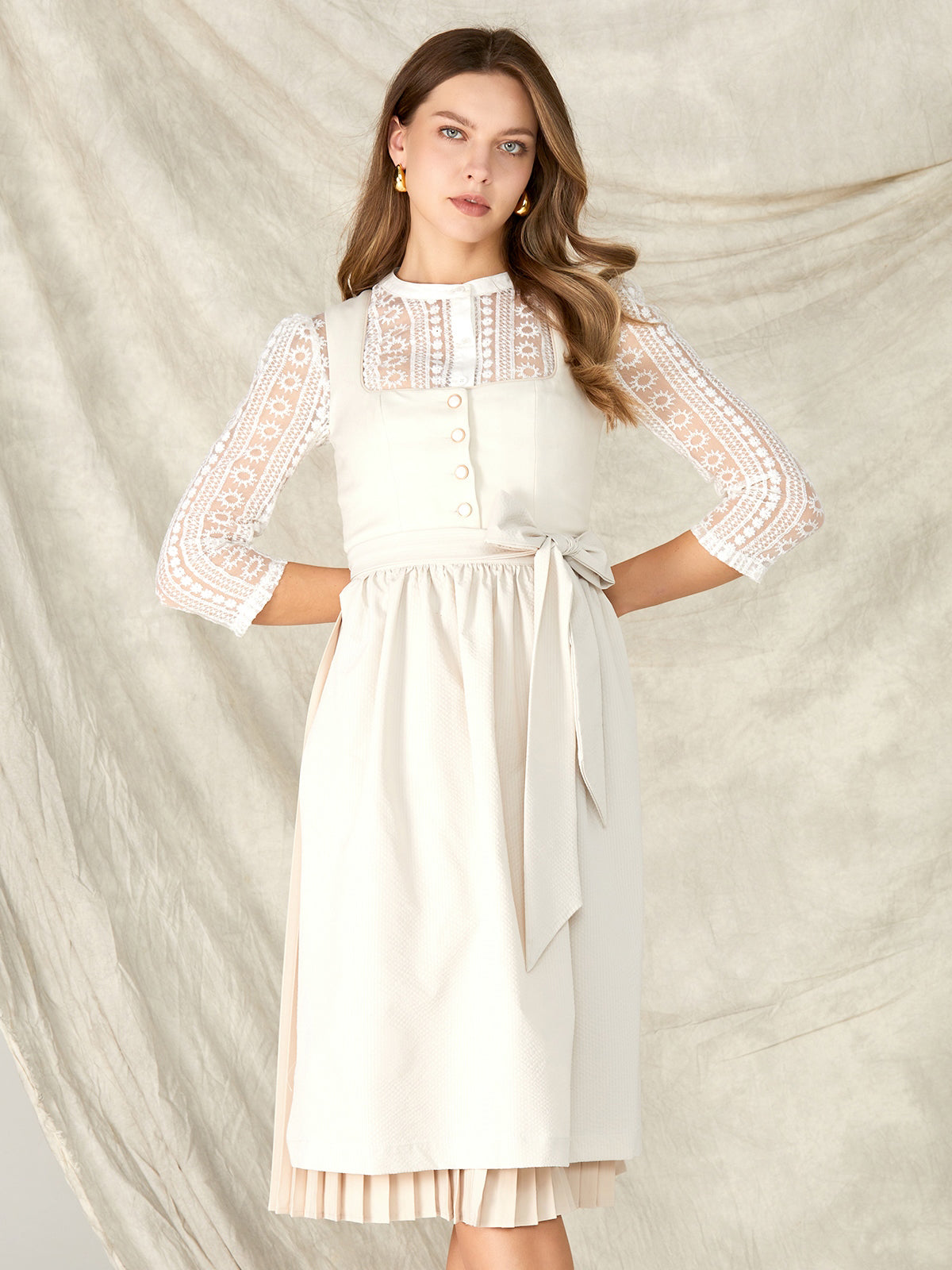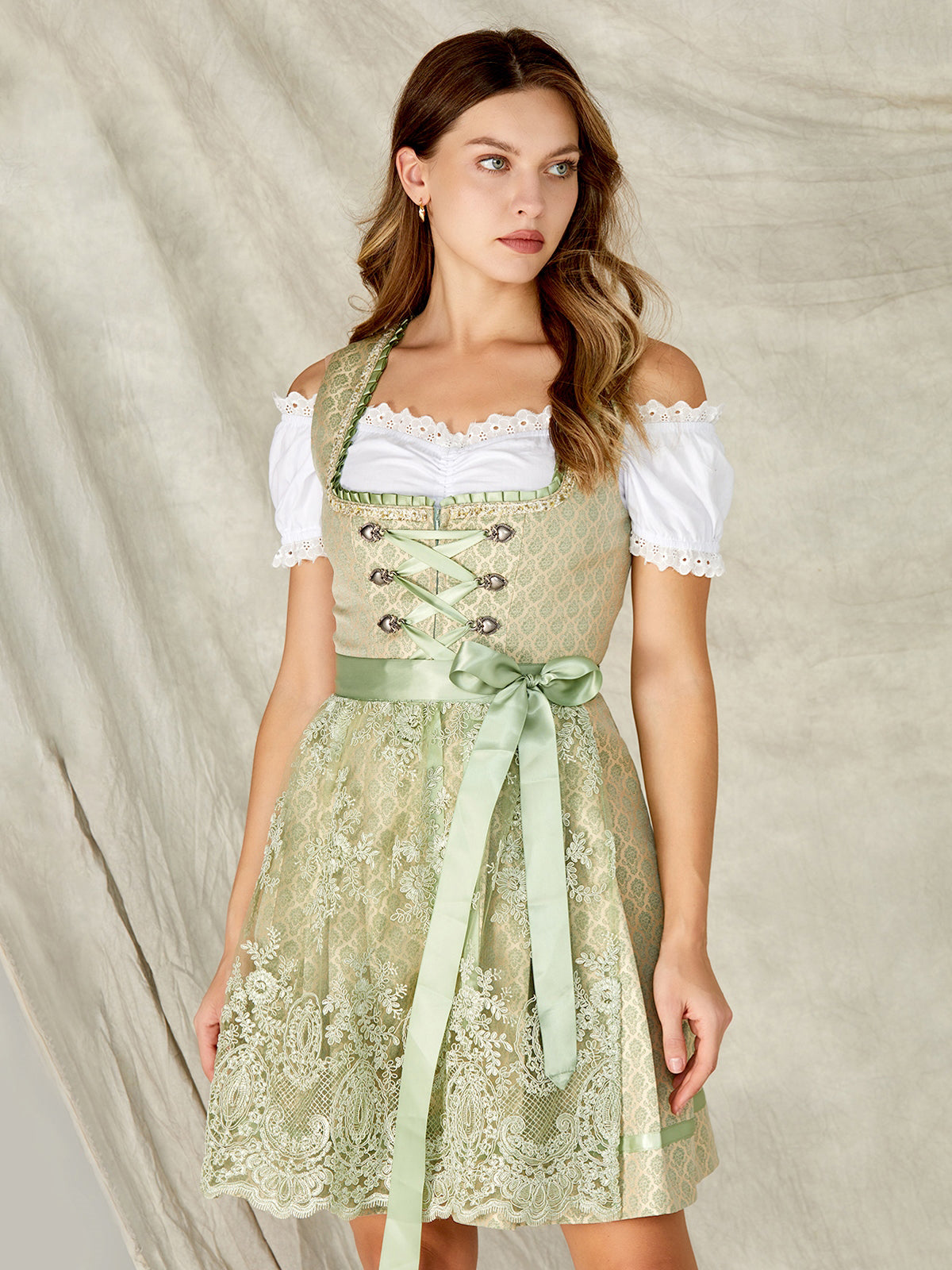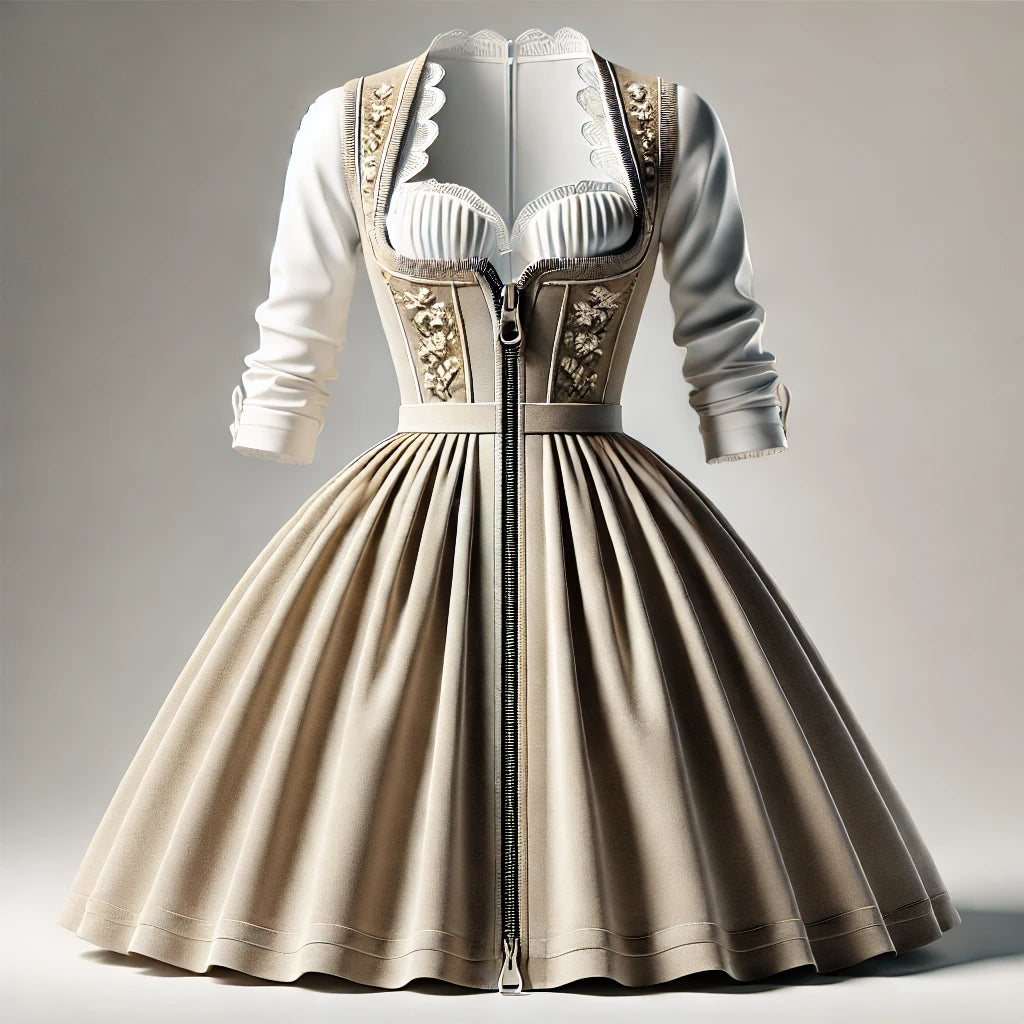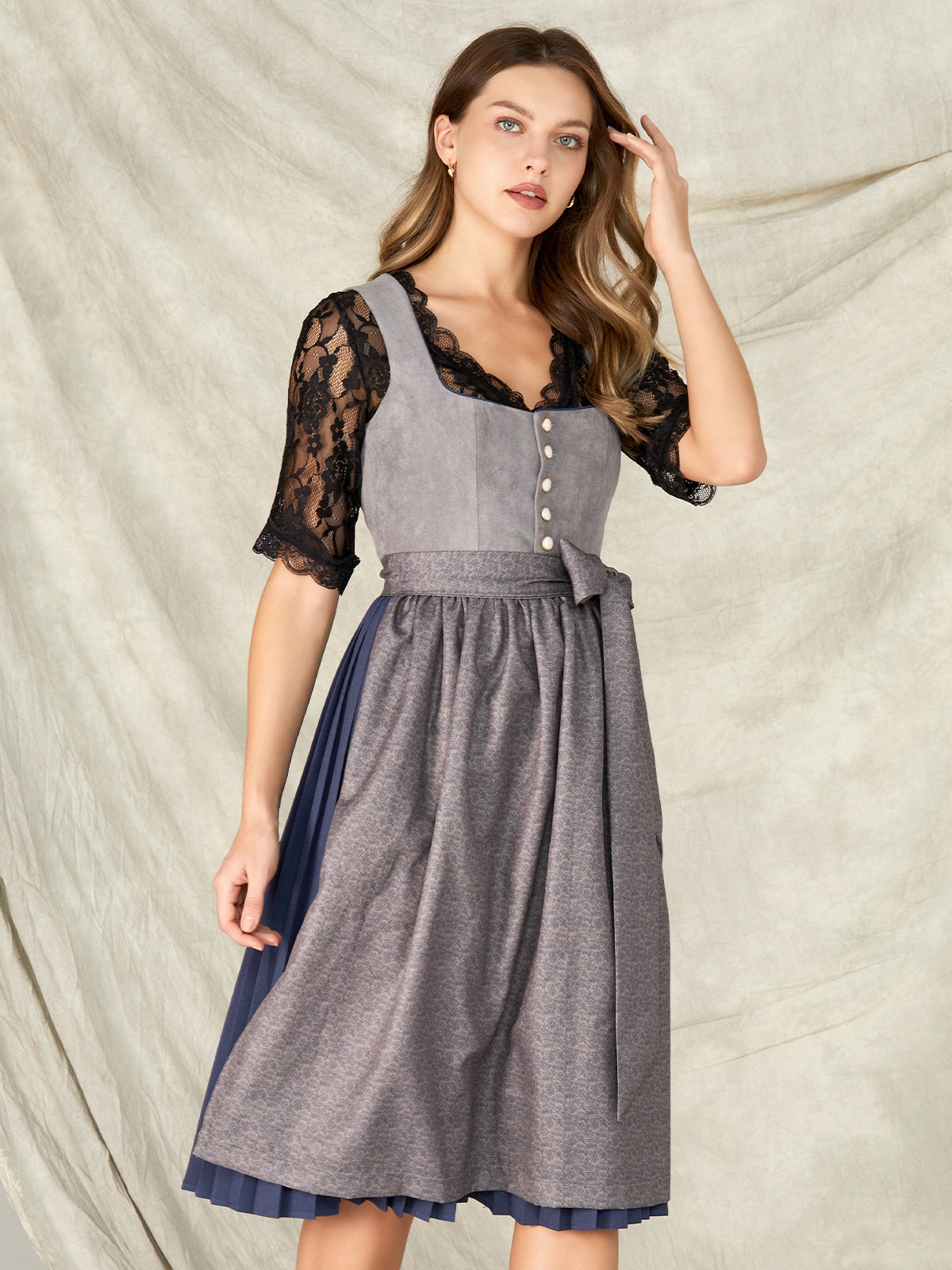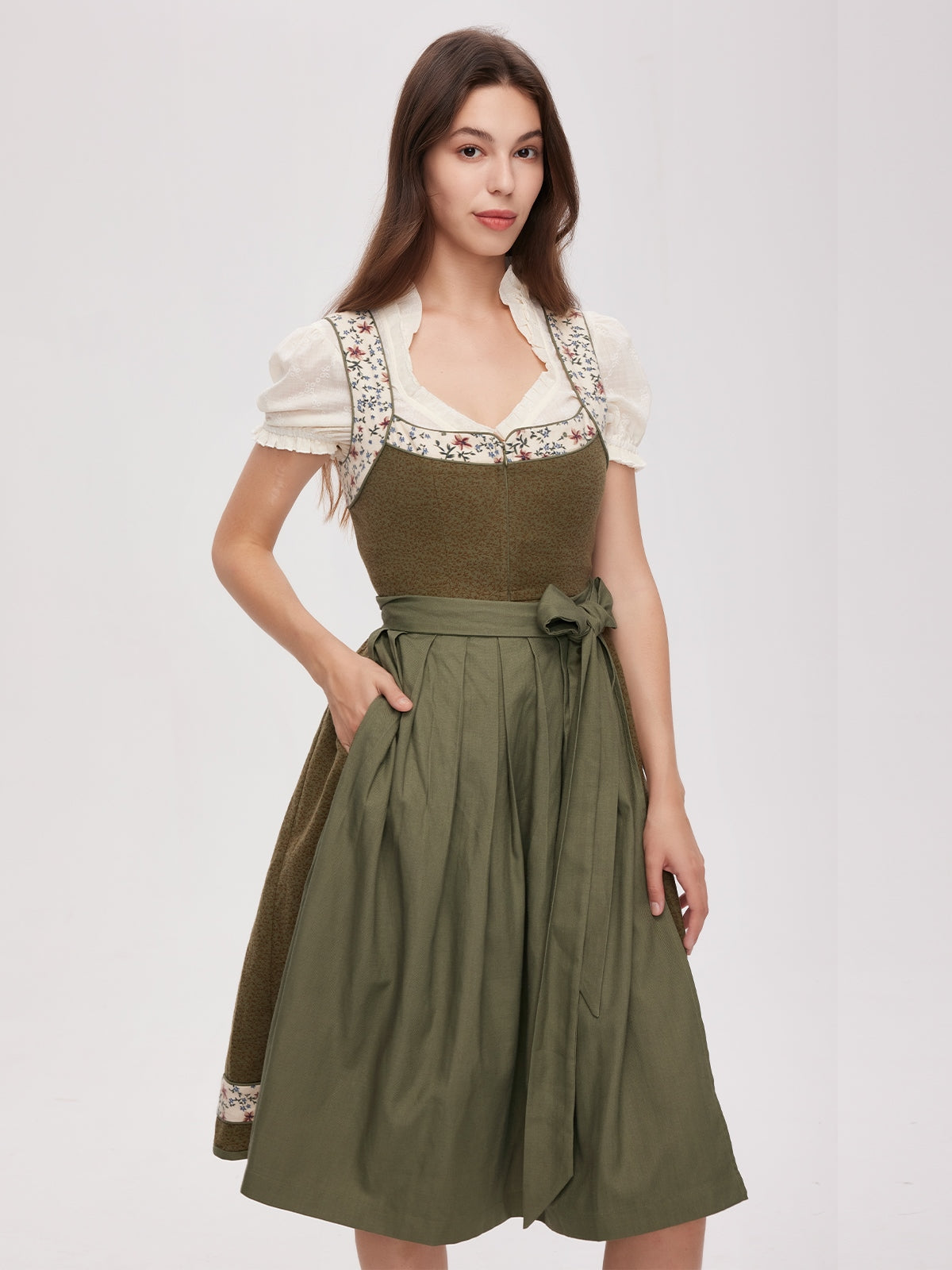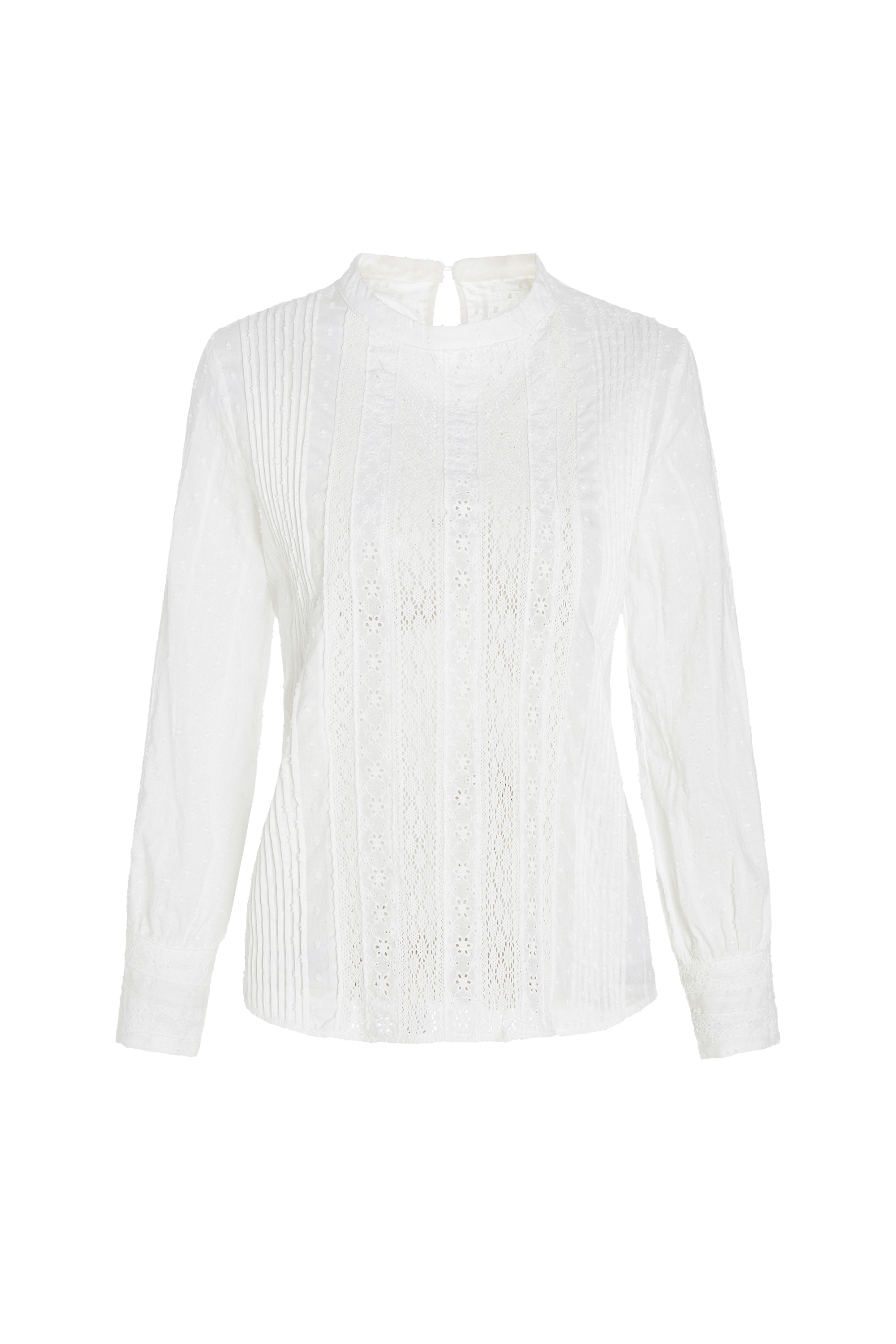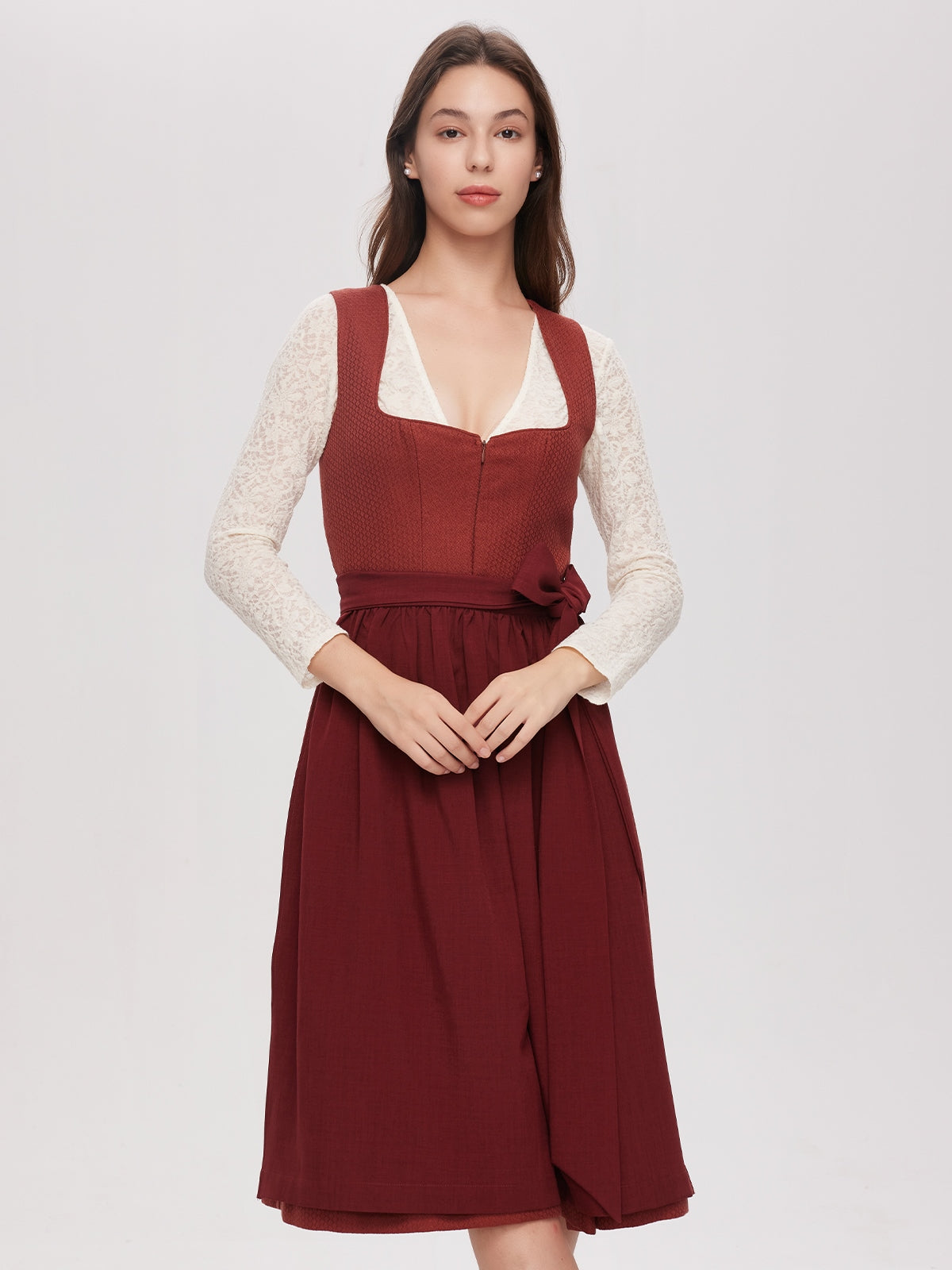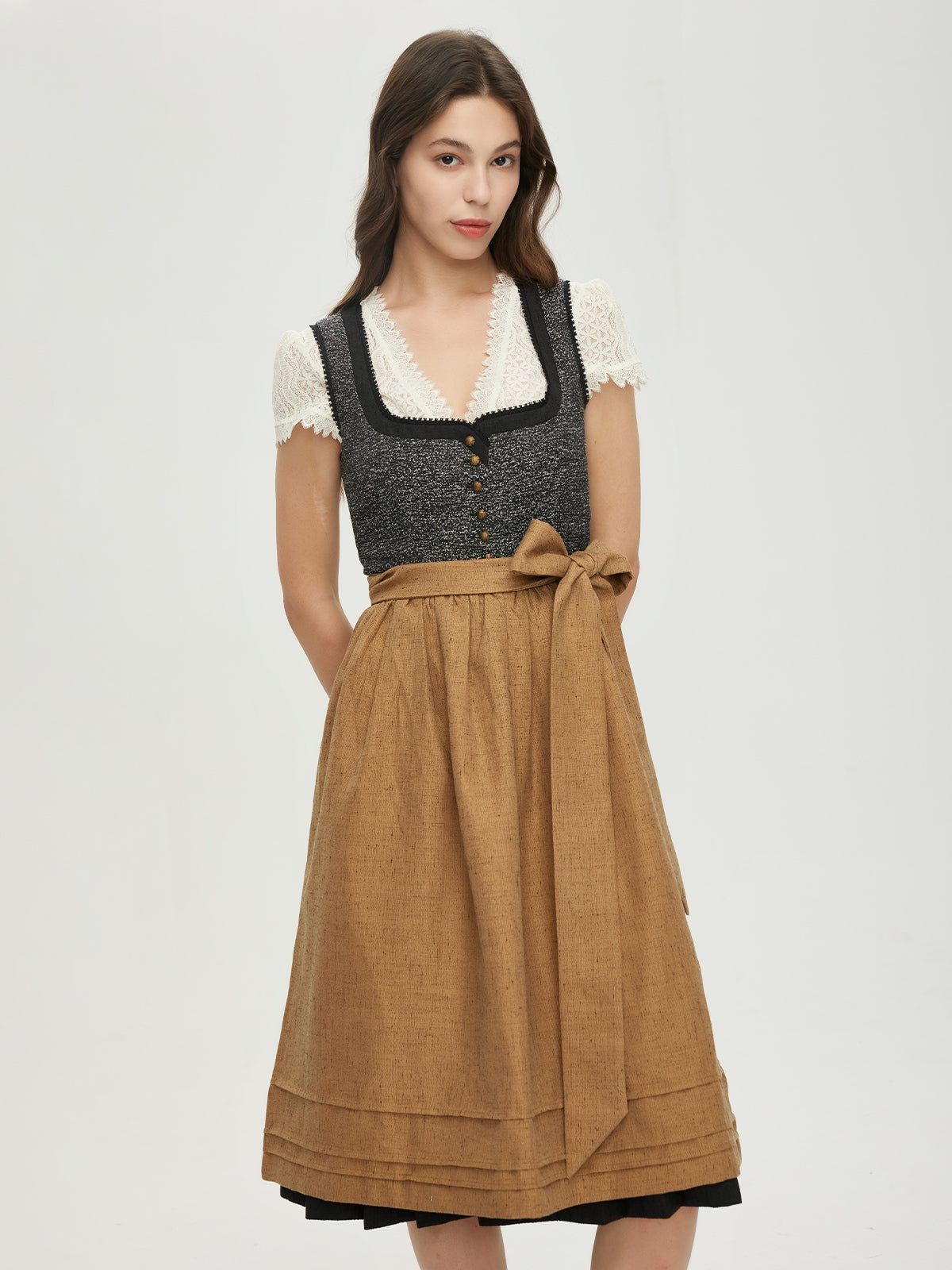Cart
0
The dirndl with a front zipper is not only a practical addition, but also a subtle revolution in traditional costume. The zipper, traditionally replaced by buttons or hooks, represents a modern woman who seeks to combine comfort with elegance. It allows the wearer to put on the dirndl more quickly while maintaining a stylish appearance. In an age where fashion is increasingly an expression of one's personality, the dirndl with a front zipper is gaining significance.
Anna's journey, which begins with the purchase of such a dirndl, reflects not only a change in fashion but also an inner transformation. The zipper becomes a symbol of the inner conflict between tradition and the freedom to make one's own choices—a struggle familiar to many women on their path to self-realization.
The practical aspect of the dirndl zipper
Traditional dirndls usually fasten with hooks, ribbons, or buttons. These details contribute to the classic aesthetic, but are often cumbersome to use. The dirndl zipper at the front solves this problem: It's easy to open and close, offering a seamless transition between practicality and elegance. This functionality is a great advantage, especially for festive occasions where the dirndl has to be put on and taken off several times.
Anna, who travels a lot for work and has little time for elaborate wardrobe changes, appreciated this practical advantage. However, it wasn't just the ease of use that influenced her decision-making process. The zipper became a metaphor for a profound inner transformation, reflected in her relationship to tradition and her family's expectations.
A sudden realization: The inner monologue
As Anna stood in front of the mirror, examining the zipper on her new dirndl, she was suddenly overcome by thoughts. "Is this really me?" she asked herself as she unzipped it and let the dirndl slide easily over her shoulders. The simple movement of opening and closing it was liberating, but at the same time, she felt a slight pang of insecurity.
"A dirndl with a zipper down the front ... Isn't that too modern?" she murmured quietly to herself. Her family had always been very tradition-conscious, and she had often conformed to the norms imposed on her. The zipper seemed like a small detail at first glance, but in her mind, it symbolized something much greater: the freedom to make her own decisions, independent of the expectations of others.
The Dirndl as a mirror of inner struggles
As Anna continued to examine the dirndl with its zippered front, she realized that the garment was more than just a choice for the upcoming occasion. It reflected her inner conflict. On the one hand, she loved the tradition and values her family embodied. On the other, she felt the need to break free from these expectations and find her own path.
"Why does this zipper feel so significant?" she asked herself. She remembered past moments when she felt she had to conform to other people's expectations. Whether it was about clothing, career, or life choices, Anna was always the one who conformed. But the zipper on this dirndl was different. It was uncomplicated, direct, simple—a small but decisive break with tradition. Exactly what she needed.
Emotional waves: The decision is solidified
On the day of the festival, Anna was torn. She had decided to wear the dirndl with the zipper up the front, but doubts remained. "Will I stand out? Will I be perceived as too modern?" she thought as she got ready. But then, as she zipped up the dress with a quick, fluid movement, she suddenly felt an unexpected clarity.
"It's just a zipper," she told herself, but deep down she knew it was much more. This moment of clarity brought her to the realization that she no longer had to compromise. The zipper symbolized for her the simplicity and directness she sought in her life. She was ready to break with tradition—or at least interpret it in her own way.
A surprising encounter: The family's reactions
When Anna arrived at the festival, she was greeted by curious glances. Her mother and grandmother wore traditional dirndls with buttons and ribbons as usual. "A zipper?" her mother asked in surprise, eyeing Anna. "That's new."
Anna took a deep breath and looked her mother in the eyes. "Yes, it's practical," she answered calmly, gently tugging at her dirndl. For a moment, it seemed as if her mother was about to say something, but then she smiled. "It suits you well," she finally said, and Anna felt the tension leave her.
This moment was a turning point. She had expected rejection, but instead, she found acceptance. It was as if the zipper had not only closed the dirndl, but also ushered in a new era in Anna's life—one in which she made her own decisions while finding support from her family.
The Meaning of the Zipper: A Metaphor for Personal Freedom
The dirndl with its front zipper became more than just a practical choice for Anna. It symbolized her ability to combine tradition and modernity without losing her identity. The zipper, so easy to use, represented the ease with which she now made her decisions. It became a symbol of her inner freedom and self-confidence.
This freedom in choosing the zipper also reflected her willingness to defy the expectations of others and forge her own path. "It's just a detail," she often thought, but in reality, it was much more. The dirndl's front zipper represented a transformation taking place in her life—a small change that had great significance.
Conclusion: The zipper as a new symbol in traditional fashion
The dirndl with a front zipper combines the best of both worlds: the classic aesthetic of traditional costume and modern functionality. It's a choice for women who not only want to look stylish but also value comfort and ease of use. The zipper allows the dirndl to retain its beauty and tradition while simultaneously making everyday life easier for the wearer.
Anna's story shows that a zipper isn't just a fashionable detail, but also a symbol of inner freedom, self-determination, and the courage to embrace tradition in a new way. Women who choose a dirndl with a front zipper aren't just making a practical choice—they're signaling that fashion is more than just outward appearance. It's an expression of one's own personality and the willingness to do things in one's own, authentic way.
Anna's journey, which begins with the purchase of such a dirndl, reflects not only a change in fashion but also an inner transformation. The zipper becomes a symbol of the inner conflict between tradition and the freedom to make one's own choices—a struggle familiar to many women on their path to self-realization.
The practical aspect of the dirndl zipper
Traditional dirndls usually fasten with hooks, ribbons, or buttons. These details contribute to the classic aesthetic, but are often cumbersome to use. The dirndl zipper at the front solves this problem: It's easy to open and close, offering a seamless transition between practicality and elegance. This functionality is a great advantage, especially for festive occasions where the dirndl has to be put on and taken off several times.
Anna, who travels a lot for work and has little time for elaborate wardrobe changes, appreciated this practical advantage. However, it wasn't just the ease of use that influenced her decision-making process. The zipper became a metaphor for a profound inner transformation, reflected in her relationship to tradition and her family's expectations.
A sudden realization: The inner monologue
As Anna stood in front of the mirror, examining the zipper on her new dirndl, she was suddenly overcome by thoughts. "Is this really me?" she asked herself as she unzipped it and let the dirndl slide easily over her shoulders. The simple movement of opening and closing it was liberating, but at the same time, she felt a slight pang of insecurity.
"A dirndl with a zipper down the front ... Isn't that too modern?" she murmured quietly to herself. Her family had always been very tradition-conscious, and she had often conformed to the norms imposed on her. The zipper seemed like a small detail at first glance, but in her mind, it symbolized something much greater: the freedom to make her own decisions, independent of the expectations of others.
The Dirndl as a mirror of inner struggles
As Anna continued to examine the dirndl with its zippered front, she realized that the garment was more than just a choice for the upcoming occasion. It reflected her inner conflict. On the one hand, she loved the tradition and values her family embodied. On the other, she felt the need to break free from these expectations and find her own path.
"Why does this zipper feel so significant?" she asked herself. She remembered past moments when she felt she had to conform to other people's expectations. Whether it was about clothing, career, or life choices, Anna was always the one who conformed. But the zipper on this dirndl was different. It was uncomplicated, direct, simple—a small but decisive break with tradition. Exactly what she needed.
Emotional waves: The decision is solidified
On the day of the festival, Anna was torn. She had decided to wear the dirndl with the zipper up the front, but doubts remained. "Will I stand out? Will I be perceived as too modern?" she thought as she got ready. But then, as she zipped up the dress with a quick, fluid movement, she suddenly felt an unexpected clarity.
"It's just a zipper," she told herself, but deep down she knew it was much more. This moment of clarity brought her to the realization that she no longer had to compromise. The zipper symbolized for her the simplicity and directness she sought in her life. She was ready to break with tradition—or at least interpret it in her own way.
A surprising encounter: The family's reactions
When Anna arrived at the festival, she was greeted by curious glances. Her mother and grandmother wore traditional dirndls with buttons and ribbons as usual. "A zipper?" her mother asked in surprise, eyeing Anna. "That's new."
Anna took a deep breath and looked her mother in the eyes. "Yes, it's practical," she answered calmly, gently tugging at her dirndl. For a moment, it seemed as if her mother was about to say something, but then she smiled. "It suits you well," she finally said, and Anna felt the tension leave her.
This moment was a turning point. She had expected rejection, but instead, she found acceptance. It was as if the zipper had not only closed the dirndl, but also ushered in a new era in Anna's life—one in which she made her own decisions while finding support from her family.
The Meaning of the Zipper: A Metaphor for Personal Freedom
The dirndl with its front zipper became more than just a practical choice for Anna. It symbolized her ability to combine tradition and modernity without losing her identity. The zipper, so easy to use, represented the ease with which she now made her decisions. It became a symbol of her inner freedom and self-confidence.
This freedom in choosing the zipper also reflected her willingness to defy the expectations of others and forge her own path. "It's just a detail," she often thought, but in reality, it was much more. The dirndl's front zipper represented a transformation taking place in her life—a small change that had great significance.
Conclusion: The zipper as a new symbol in traditional fashion
The dirndl with a front zipper combines the best of both worlds: the classic aesthetic of traditional costume and modern functionality. It's a choice for women who not only want to look stylish but also value comfort and ease of use. The zipper allows the dirndl to retain its beauty and tradition while simultaneously making everyday life easier for the wearer.
Anna's story shows that a zipper isn't just a fashionable detail, but also a symbol of inner freedom, self-determination, and the courage to embrace tradition in a new way. Women who choose a dirndl with a front zipper aren't just making a practical choice—they're signaling that fashion is more than just outward appearance. It's an expression of one's own personality and the willingness to do things in one's own, authentic way.

